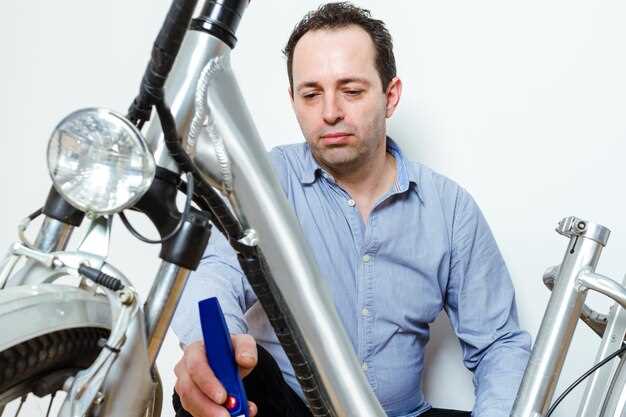
When considering the purchase of a bicycle, it’s crucial to understand the necessary paperwork involved to ensure a smooth buying process. Unlike the complexities surrounding the registration of motorcycles, acquiring a bicycle typically requires less documentation. However, having the proper paperwork can help avoid complications and streamline ownership.
The first step in the process is often verifying the seller’s legitimacy. An important document to request is a receipt or proof of purchase. This not only serves as a confirmation of the transaction but may also be essential for any future warranty claims. Additionally, if you’re buying from a retailer, a warranty registration form may be required to activate the coverage.
Another consideration is the registration of your bicycle with local authorities. While not all areas mandate registration for bicycles, some places implement this requirement for theft prevention and tracking purposes. Knowing your local regulations can help you understand whether this step is necessary or beneficial for your new bike.
In conclusion, while the paperwork for purchasing a bicycle is generally less complicated than that for motorcycles, it is still important to ensure you have all necessary documents in place. This will facilitate a hassle-free purchase and help safeguard your investment.
Necessary Documents for Buying a Bicycle: What You Need to Know

When purchasing a bicycle, understanding the necessary paperwork is essential to ensure a smooth transaction. Here are the key documents you should be aware of:
1. Identification: Most retailers will require a form of identification, such as a driver’s license or a government-issued ID. This helps confirm your identity during the purchase.
2. Proof of Address: Some businesses may ask for a utility bill or a lease agreement to verify your current address. This is especially common if the bicycle is being registered for warranty or insurance purposes.
3. Registration Documents: In certain regions, registering your bicycle may be obligatory. This involves filling out a registration form provided by the local authorities or the retailer. The registration typically includes details like the bicycle’s serial number and your contact information.
4. Receipt of Purchase: Always request a receipt when buying a bicycle. This serves as proof of purchase and may be necessary for future warranty claims or if you decide to sell the bicycle later.
5. Insurance Information: If you plan to insure your bicycle, have the necessary information ready, such as the bicycle’s value and serial number. Some insurers may also require documentation of the purchase.
Being prepared with these documents can facilitate a hassle-free buying experience and ensure proper ownership of your new bicycle.
Motorcycle Purchase Requirements: Title, Bill of Sale, and More

When purchasing a motorcycle, there are several essential documents required to complete the transaction legally and efficiently. Understanding these requirements can help ensure a smooth transfer of ownership.
The most critical document is the title, which proves legal ownership of the motorcycle. The seller must provide a clear title, free of liens, that includes the details of the motorcycle such as the Vehicle Identification Number (VIN), make, model, and year. If the motorcycle is financed, it’s vital to ensure that the lender releases the title at the time of sale.
A bill of sale is another necessary document that outlines the terms of the sale. This document serves as a receipt and should include the buyer’s and seller’s names, the motorcycle’s details, the sale price, and the date of the transaction. Having a bill of sale can be beneficial for both parties, especially if any disputes arise in the future.
Registration is an important step after acquiring the motorcycle. Once the purchase is finalized, the buyer must register the motorcycle with the appropriate state department of motor vehicles (DMV). This process typically requires the title, bill of sale, proof of identity, and payment of registration fees. Registration ensures that the motorcycle is legally recognized and that the owner has the right to ride it on public roads.
Additionally, some states may require an odometer disclosure statement that verifies the motorcycle’s mileage at the time of sale. This is particularly relevant for preventing fraud by ensuring that the mileage recorded reflects the true distance the motorcycle has traveled.
Lastly, obtaining insurance is a crucial step prior to riding the motorcycle. Most states require proof of insurance for registration, making it an essential aspect of the purchasing process. Having adequate coverage protects the rider and complies with state laws.
Steps for Registering Your Bicycle or Motorcycle with Local Authorities
Registering your motorcycle or bicycle with local authorities is an important step in ensuring legal ownership and compliance with local regulations. Here are the essential steps to follow:
1. Gather Required Documents: Before initiating the registration process, collect all necessary paperwork. This typically includes proof of purchase, identification, and any previous registration documents. For motorcycles, you may also need to provide a bill of sale and a certificate of title if applicable.
2. Check Local Regulations: Different jurisdictions have varying requirements for registration. Research your local laws regarding bicycle and motorcycle registration to understand what is necessary in your area. This may include registration fees, inspections, and specific paperwork.
3. Visit the Relevant Authority: Go to the office responsible for vehicle registration in your locality. This could be a department of motor vehicles or a specialized registration office. Ensure you bring all the gathered documents to facilitate the process.
4. Complete the Registration Form: Fill out the required registration form accurately. Provide details about the vehicle, including make, model, year, and identification numbers. For motorcycles, specific safety and equipment details may also be required.
5. Pay Registration Fees: Prepare to pay any registration fees associated with your application. Fees can vary widely based on location and type of vehicle. Keep receipt as proof of payment.
6. Receive Registration Certificate: Once your application is processed and approved, you will receive a registration certificate. This document serves as legal proof of registration and should be kept in a safe place.
7. Obtain License Plates or Stickers: Depending on local laws, you may also be issued license plates or registration stickers. Ensure these are displayed as required on your motorcycle or bicycle to comply with regulations.
8. Keep Documentation Current: Regularly check to ensure your registration remains valid. Renew it as necessary and maintain accurate records as required by local authorities.
Following these steps will help you successfully register your bicycle or motorcycle, ensuring compliance and peace of mind as you enjoy your rides.
